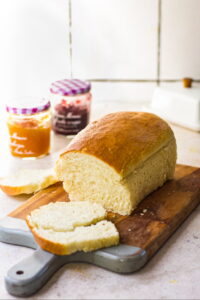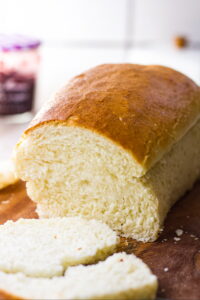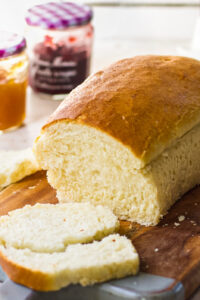Hello, bread buddies! I’m super excited to tell you about my latest baking adventure. If you’ve been keeping up with my kitchen stories, you might remember when I made 100% whole wheat bread. It was so much fun and tasted really good too!
Today, I’m thrilled to guide you through the process of making 100% Suji bread. Yes, you heard that right – Suji bread! It’s all about simplicity and warmth.
Let’s roll up our sleeves, preheat our ovens, and fill our homes with the irresistible aroma of homemade bread. Together, we’ll create something truly special and guilt free. From my kitchen to yours, let’s savour the simple pleasures of homemade bread and rediscover the joy of wholesome, nourishing fare. Here’s to the timeless tradition of 100% suji bread—a true staple of the human experience, and a delicious reminder of the beauty of simplicity.

INGREDIENTS USED IN MAKING 100% SUJI BREAD
SEMOLINA
Semolina is a type of flour made from durum wheat. It has a coarse texture and is commonly used in savouries and bread making. In Suji bread, semolina adds a unique flavor, texture, and nutritional profile to the loaf. Always use ground semolina or grind it in a mixer grinder so that it blends seamlessly into the bread dough, resulting in a smooth and cohesive mixture. This step allows you to fully enjoy the flavor and nutritional benefits of semolina in your homemade Suji bread.
It has a distinct nutty flavor that adds depth to the bread. When incorporated into the dough, it imparts a subtle earthiness and sweetness that complement the other ingredients.
YEAST
Instant yeast is responsible for leavening the bread dough, causing it to rise and expand during fermentation. As the yeast feeds on the sugars in the dough, it produces carbon dioxide gas as a by product.
Unlike active dry yeast, which requires proofing in warm water before being added to the dough, instant yeast can be mixed directly into the dry ingredients. This saves time and streamlines the bread-making process, allowing for faster fermentation and proofing. Instant yeast activates more quickly and efficiently than active dry yeast, which can help speed up the rising time and shorten overall production time.
Overall, instant yeast is an indispensable ingredient in whole wheat bread-making, providing efficient leavening action, faster fermentation, consistent results, and versatility in a variety of recipes.
SUGAR
While yeast primarily feeds on carbohydrates such as starches, small amounts of sugar can help kickstart the fermentation process by providing a readily available energy source.
In bread-making, sugar helps to hold onto water molecules, preventing the bread from drying out too quickly and extending its shelf life. This can result in a softer and more tender crumb.
WATER
Water is the primary liquid used in bread dough, hydrating the flour and activating the yeast. Yeast cells require water to metabolize sugars and multiply, leading to the release of carbon dioxide bubbles that cause the dough to rise. Water is essential for gluten development, which gives the bread its structure and texture. Steam is released as water evaporates from the surface of the dough in the hot oven. This steam “sets” the crust early in the baking process, allowing the bread to continue expanding and rising before the crust hardens.
MILK
Milk contains proteins and fats that can tenderize the structure of the bread, making it more delicate and less dense. This results in a softer and more enjoyable texture. I have used Nestle toned milk for this recipe. You can swatch it with any kind of milk. Bread made with milk tends to stay fresher longer than bread made with water alone. The fats and sugars in milk help to retain moisture in the bread, slowing down the staling process and extending its shelf life.
OIL
Oil helps to tenderize the crumb of the bread, making it softer and more palatable. It also helps to improve the texture of the bread by lubricating the gluten strands and preventing them from sticking together too tightly. This results in a lighter and airier crumb, with a more open and uniform structure. Oil applied to the surface of the dough before baking can help to soften the crust of the bread, resulting in a more tender and chewy texture.

EQUIPMENTS USED FOR MAKING 100% SUJI BREAD
The kind of equipment you use can hugely impact the final product. So, make sure to always use the best of the equipment that is available.
Measuring Cups and Measuring Spoons. are an integral part of any baker’s kitchen and it’s very important to measure ingredients with precision.
I used a whisk and a wooden spoon to combine all the ingredients. This equipment are basics and you can find them at any shop near you. They come in handy in so many recipes.
I have used Kitchen Aid stand mixer to make this bread, but you can use any stand mixer to make It.
I used an Alda loaf pan to make this 100% suji bread.
Finally, I baked 100% suji bread in my Borosil 60L oven.
WHY TO BAKE IT WITH WATER BATH?
- Moisture Retention: The steam generated by the water bath creates a humid environment in the oven, which helps prevent the bread from drying out during baking.
- Crust Development: The water bath also helps facilitate crust development by delaying the formation of a hard crust on the bread’s surface. This allows the crust to gradually develop a desirable golden-brown color without becoming too hard.
- Even Baking: The gentle heat from the water bath promotes even baking throughout the loaf, ensuring that the bread rises uniformly and cooks evenly.
HOW TO SETUP THE WATER BATH
A steamy environment slows the formation of the hard crust and thus allows more oven spring. Commercial bakeries have ovens that can inject steam into the chamber. But you can do this in your home oven as well by following these steps-
- Start by preheating the oven at 210 degrees celcius for 5-10 minutes and place the oven tray at the bottom of the oven and cooling rack just above it.
- Once the oven is preheated place your proofed bread on the cooling rack.
- Using your oven mitts, partially pull out the oven tray from the oven and pour room temperature water into the tray. This will create steam inside the oven.
- Now, bake the bread for 25-30 minutes or until the top turns golden brown.
ALWAYS USE FINELY GROUND SEMOLINA/SUJI
Ground semolina has a finer texture compared to coarse semolina. This finer texture allows it to blend more smoothly with other ingredients in the dough, resulting in a more uniform and cohesive mixture. It also contributes to a softer and more even crumb texture in the finished bread.
To make ground semolina:
- Measure the desired amount of semolina needed for your recipe.
- Place the semolina in a blender, food processor, or spice grinder. Ensure that the appliance is clean and dry before use.
- Pulse or grind the semolina until it reaches a fine, powdery consistency.
- Once ground, transfer the semolina flour to a clean and dry container. Use it immediately in your Suji bread recipe or store it in a cool, dry place for future use

OTHER RELATED RECIPES FROM THE BLOG
TIPS TO MAKE 100% SUJI BREAD
- If you’re using coarse semolina, consider grinding it into a finer texture using a mixer or food processor. This ensures that the semolina blends smoothly into the dough, resulting in a more cohesive mixture and a finer crumb in the finished loaf.
- Semolina absorbs more water compared to regular wheat flour. So the dough will be quite liquid in start but it will gradually get better.
- Kneading is crucial for developing gluten in the dough, which gives the bread its structure and texture. Knead the dough thoroughly for at least 10-15 minutes to ensure proper gluten development.
- Preheat your oven to the recommended temperature before baking the bread. Bake the loaf for the specified time, but keep an eye on it towards the end of the baking process to prevent over-browning.
- Always bake Suji bread using a water bath to retain moisture and prevent the bread from drying out during baking.
- Allow the baked Suji bread to cool completely on a wire rack before slicing. This resting period allows the bread’s internal moisture to redistribute evenly, resulting in a softer texture and better flavor.
- Store leftover Suji bread in an airtight container or resealable bag at room temperature for up to 2-3 days.
- 2 cups suji, finely ground
- 1+1/2 tsp instant yeast
- 1+1/2 tbsp sugar
- Pinch of salt
- ¾ cup water
- ¼ cup milk
- 3 tbsp oil
- Milk, for brushing
- Add suji, sugar, yeast, and salt in a large bowl and give it a quick whisk.
- Now, add in the water and milk and mix using a wooden spoon to form a batter.
- Let the batter rest for 10 minutes. This will ensure that semolina has absorbed all the water.
- After 10 minutes, start kneading the dough in a stand mixer using a hook attachment. You’ll notice the dough beginning to come together within 1-2 minutes. Continue kneading until it passes the windowpane test.
- Now, add oil to the dough and knead it again until the dough absorbs the oil.
- Once the dough is formed, transfer it in a large bowl greased with oil. Cover the bowl with a cloth and let it proof for 1 hour or till doubled in volume.
- Knock down the dough after the first proofing.
- Roll out the dough into a rough rectangle of ½ inch thickness. Then, starting from one shorter end, roll in the dough to form a log. Make sure the pinch and lock the dough after every turn.
- Transfer this log in a greased 8X4 inch loaf pan and cover again for second proofing. Let it proof for another 30 minutes or till doubled in volume.
- Meanwhile, preheat the oven at 210 degrees Celsius.
- Once the dough has risen, brush some milk on top.
- Bake the bread with a water bath to ensure it doesn’t dry out while baking for 30 minutes or until the top is golden brown.
To enjoy more such recipes, you can buy my recipe books from the links mentioned below:
- Bake with Shivesh- check here
- A Cookbook For Special Days, Special People – check here
- Eggless Baking With Shivesh- check here
- Desserts For Every Mood- check here
If you like my 100% Suji Bread recipe and happen to make them in your kitchen, do tag me on Instagram and share pictures with me using #Bakewithshivesh. Happy Baking!

 Hello. I'm Shivesh Bhatia, a food blogger and food stylist from Delhi, India. Welcome to Bake With Shivesh, where I'll help you create magic in your kitchens with my simple recipes.
Hello. I'm Shivesh Bhatia, a food blogger and food stylist from Delhi, India. Welcome to Bake With Shivesh, where I'll help you create magic in your kitchens with my simple recipes.
Leave a Reply